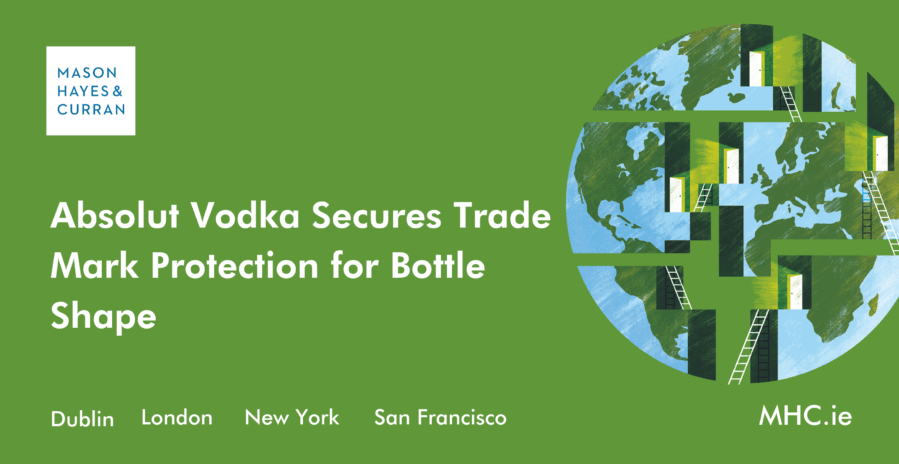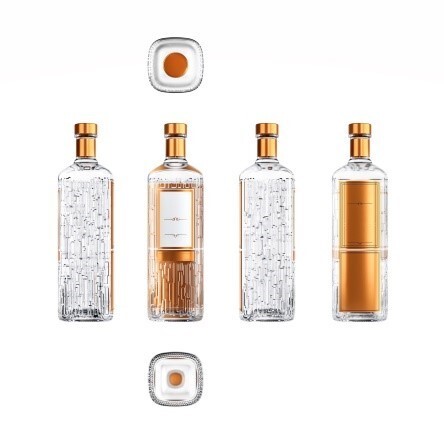
The European Union Intellectual Property Office (EUIPO) Fifth Board of Appeal has recently held that the shape of a vodka bottle is sufficiently distinctive to qualify for trade mark protection. 3D trade marks are often regarded as being difficult to register. However, this decision should serve as a reminder to brand owners that where the shape of their products or packaging departs from the norm, those shapes may be protectable as trade marks. Given that trade mark protection can potentially last indefinitely, if renewed, it is a valuable IP right protection for brand owners. We consider the impact of this decision.
The Absolut Company Aktiebolag (Absolut), in February 2019, applied to register the below 3D mark as a European Union Trade Mark (EUTM). The application sought to protect the following goods in Class 33: “Alcoholic beverages, namely vodka.”

The EUIPO Examiner entirely refused the application pursuant to Article 7(1)(b) of the European Union Trade Mark Regulation (EUTMR) in September 2021. It was refused on the basis that the relevant consumers would not perceive the sign as being an indicator of commercial origin. In other words, the mark was not considered distinctive for the goods in question.
Appeal
Absolut appealed the decision and argued that the bottle shape was highly distinctive given the combination of various fanciful features which when viewed together, amounted to more than the mere sum of the individual parts. Overall, Absolut submitted that the totality of these features distinguished the shape mark applied for from the “usual shapes, forms and colours of vodka bottles”. Therefore, they argued that the relevant public could “easily recognise the imaginative bottle getup of Absolut,” and would perceive the bottle as “an indication of a particular manufacturing company responsible for the product at stake.” The ‘fanciful features’ of the bottle referenced by Absolut included the:
- Highly unusual closure alongside the separated foil, each having the unusual colour ‘copper’

- Eye-catching frames, consisting of vertical and horizontal lines covering most of the back of the bottle shining through the bottle’s glass

- Innovative and exceptional maze-like surface structure applied to the bottle’s sides which is nowhere to be seen on the entire market and helps to make the vodka packaging easily recognisable

- ‘Optical effect’ created by the copper-coloured back relief shining through and being perceived also from the front of the bottle; and

- Unusual ‘square shape’ of the bottom of the bottle departing from the norms and customs in the relevant trade. Bottles in the vodka market are generally ‘cylindrical’ or ‘oval’ and do not contain a square-shaped bottom. A ‘look-through’ optical effect created by the ‘copper’- coloured cap ‘shining through’ the bottle
In addition, Absolut pointed to the fact that the same complex shape mark had been successfully registered as a trade mark in the US. They also relied on additional EU case law where various other bottle shapes had qualified for trade mark protection. For example, they relied on a similar case involving Bacardi, where the below depicted bottle shape was held to be distinctive and as such proceeded to registration as an EUTM protecting “alcoholic beverages (except beers).”

Decision
The EUIPO Fifth Board of Appeal held that the following three elements of the Absolut bottle shape do not depart significantly from the available forms and customs on the market:
- Closure of the bottle in the ‘copper’ colour
- Rectangular body structure and further features such as short neck, conical bottle shoulder, bottle structure and proportions, and
- Surface design consisting of a very striking crystal-like structure.
Conversely, the Board was satisfied that the following three elements will not go unnoticed by consumers and have a strong impact on the perception of the whole shape of the bottle:
- The design of the back of the bottle being entirely ‘copper’ colour
- The front label consists of a prominent frame in the unusual ‘copper’ colour, and
- The copper coloured neck foil (neck wrapper).
Ultimately, and on balance, the Board was satisfied that the relevant consumers of Vodka will be able to repeat, or avoid, the experience of purchasing the goods solely on the basis of the particular combination of the various elements of the mark. It was therefore satisfied that the shape of the bottle departs sufficiently from others available on the market and is sufficiently distinctive.
Comment
Although filed as a 3D shape mark, the use of colour was clearly an important factor in the Board’s decision. Due to its size and prominence on the Absolut vodka bottle, the EUIPO Board commented that the copper colour scheme was “eye-catching and striking.” The Board also noted that shades or nuances ranging from copper to brown or gold which covered a significant part of the shape of the bottle precluded any finding of non-distinctiveness.
Brand owners should take note that the EUIPO will take a number of factors into account when deciding whether bottle and packaging shapes are distinctive enough to be registered as trade marks. In particular, where the shape mark involved meets the below criteria, it will be capable of being registered as an EUTM:
- More than one “eye-catching and striking” colour
- Is not so complex that it will be remembered by consumers, and
- Where it differs sufficiently from those already available in the relevant market.
For more information, contact a member of our Intellectual Property Team.
The content of this article is provided for information purposes only and does not constitute legal or other advice.




